
The Alps are the highest and most extensive mountain range system that lies entirely in Europe, stretching approximately 1,200 km (750 mi) across seven Alpine countries : France, Switzerland, Italy, Liechtenstein, Austria, Germany, and Slovenia.

The Pennine Alps, also known as the Valais Alps, are a mountain range in the western part of the Alps. They are located in Switzerland (Valais) and Italy.

The Graian Alps are a mountain range in the western part of the Alps.

The Aosta Valley is a mountainous autonomous region in northwestern Italy. It is bordered by Auvergne-Rhône-Alpes, France, to the west, Valais, Switzerland, to the north, and by Piedmont, Italy, to the south and east. The regional capital is Aosta.

Aosta is the principal city of the Aosta Valley, a bilingual region in the Italian Alps, 110 km (68 mi) north-northwest of Turin. It is situated near the Italian entrance of the Mont Blanc Tunnel, at the confluence of the Buthier and the Dora Baltea, and at the junction of the Great and Little St Bernard Pass routes.

The Little St Bernard Pass is a mountain pass in the Alps on the France–Italy border. Its saddle is at 2188 metres above sea level. It is located between Savoie, France, and Aosta Valley, Italy, to the south of the Mont Blanc Massif, exactly on the main alpine watershed. There is also a Great St. Bernard Pass, famous for giving the St Bernard breed its name, and a San Bernardino Pass.

Flagstone (flag) is a generic flat stone, sometimes cut in regular rectangular or square shape and usually used for paving slabs or walkways, patios, flooring, fences and roofing. It may be used for memorials, headstones, facades and other construction. The name derives from Middle English flagge meaning turf, perhaps from Old Norse flaga meaning slab or chip.
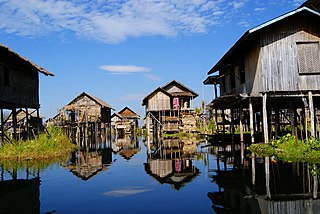
Stilt houses are houses raised on stilts over the surface of the soil or a body of water. Stilt houses are built primarily as a protection against flooding; they also keep out vermin. The shady space under the house can be used for work or storage.

A granary is a storehouse or room in a barn for threshed grain or animal feed. Ancient or primitive granaries are most often made of pottery. Granaries are often built above the ground to keep the stored food away from mice and other animals and from floods.

Brusson is a town and comune in Val d'Ayas, a left minor valley of the Aosta Valley region in Italy.

Génépi or génépy or genepì is a traditional herbal liqueur or aperitif popularized in the Alpine regions of Europe. Genepi also refers to alpine plants of the genus Artemisia that provide the liqueur's flavor and color, and the French Savoy region adjacent to the Aosta Valley, where the Artemisia genepi plants grow and where the beverage is commonly produced.
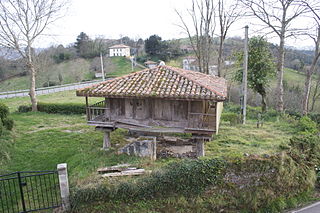
An hórreo is a typical granary from the northwest of the Iberian Peninsula, built in wood or stone, raised from the ground by pillars ending in flat staddle stones to prevent access by rodents. Ventilation is allowed by the slits in its walls.
The development of music in the Aosta Valley region of Italy reflects the multilingual make-up of the region including French, Valdôtain and recently Italian.

Ayas is a comune sparso in the Aosta Valley region of northwestern Italy, with 1359 inhabitants in 2010.

Bard is a town and comune in the Aosta Valley region of northwestern Italy. It is part of the Unité des communes valdôtaines du Mont-Rose and has a population of 134.
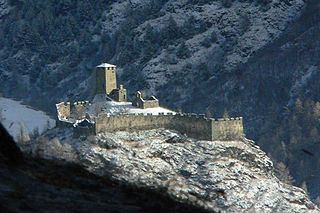
The Castle of Graines is a castle in Val d'Ayas, located near the village with the same name in the municipality of Brusson, Aosta Valley, northern Italy.
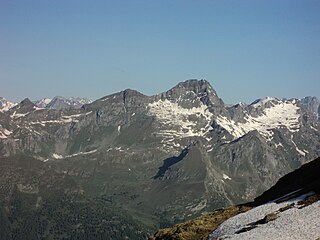
Grand Tournalin (3,379m) is a mountain of the Monte Rosa Massif in the Pennine Alps in Aosta Valley, Italy. It is the highest mountain between the Ayas Valley and Valtournenche. The mountain is composed of two summits, the north being higher than the south summit by just 9m.

Corno Bussola is a 3,023 metres high peak on the Italian side of the Pennine Alps.
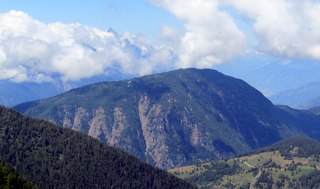
The Testa di Comagna is a 2,106 metres high peak on the Italian side of the Pennine Alps.

The Palasinaz Lakes are a group of lakes located in the Italian Alps, in the Aosta Valley region of northern Italy. They are of glacial origin and are situated in the southern foothills of the Monte Rosa group and are accessible from the villages of Brusson and Champoluc. The group is composed of the following lakes: the Lac Long, the Lago Pocia, the Lac du Couloir, the Lac Vert, and, the Lago della Battaglia.






















